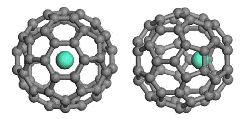Department of Chemistry
Document Type
Article
Date of this Version
11-1-1999
Abstract
Effects of the liquid on atomic force microscopy (AFM) imaging are examined for a model system consisting of a hexagonal flake of seven Lennard-Jones (LJ) atoms as a multiatom tip, a monolayer of LJ crystal containing a single point defect as a substrate, and three-site model water as the liquid. A previous simulation [Koutsos et al., Europhys. Lett. 26, 103 (1994)] has shown that the true atomic resolution of a point defect cannot be achieved in vacuum by use of the multiatom tip. Here we examine the feasibility of such atomic resolution when both the tip and substrate are immersed in a liquid. The liquid-induced interaction between the tip and the substrate is evaluated in the framework of the integral equation theory of molecular fluids extended for the system consisting of an infinitely large crystal. It is found that the potential of mean force indeed manifests the point defect even when the tip and the substrate are a few Angstroms apart. This implies that in the liquid environment the point defect could be discerned in the constant-height mode of AFM measurement. For the constant-load mode of AFM, a characteristic potential can be used to determine the stable, metastable, and unstable vertical position (height) of the tip at any lateral position. The contour surface of the stable heights reveals periodic features of the underlying lattice of the substrate except in the vicinity of the defect, provided certain load is applied.


Comments
Published by Am Physical Soc. Phys. Rev. B 60, 14328 - 14333 (1999). Copyright 1999. Permission to use. http://link.aps.org/abstract/PRB/v60/p14328 .